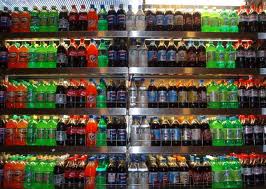There is only one food that studies have consistently shown to be directly linked to obesity and to Type II Diabetes … sugar sweetened beverages. Sugar sweetened beverages have become so bandied about in the global health world they are now known by the acronym SSB.
 According to Margo Wootan, director of nutrition policy at the Center for Science in the Public Interest, “… sugary soft drinks are the number one source of calories in our diets. We get more calories from sodas and sugary drinks than any other individual food — cake, cookies, pizza, anything.”
According to Margo Wootan, director of nutrition policy at the Center for Science in the Public Interest, “… sugary soft drinks are the number one source of calories in our diets. We get more calories from sodas and sugary drinks than any other individual food — cake, cookies, pizza, anything.”
Chicago area hospitals are phasing out all SSBs including so called energy drinks.
The dire effect of SSBs on our health has prompted New York City Mayor Michael Bloomberg to propose limiting the portion size of SSBs to 16 oz. Vendors violating the size restriction could be fined $200 per infraction.
Sugary drink consumption may just be a part of the U.S. obesity epidemic, but the products are the largest single source of sugar in the diet and have a major impact on health, Thomas Farley, New York City’s health commissioner, said.. Reducing obesity by just 10 percent in New York City would save about 500 lives a year, he added. “It’s ridiculous to say we shouldn’t try something that’s only going to solve a portion of the problem,” he said at an event sponsored by the Center for Science in the Public Interest, a group that has long advocated against junk food.
Bloomberg’s proposal will be submitted June 12 to the New York City Board of Health, which will then vote on it after a three-month comment period. If approved by the board, the ban would take effect early next year.
Don’t think you are doing yourself any favors by choosing sweetened tea over soda. While I am a Southern lady through & through, real southern sweet tea is off my table. Even 100% pure fruit juices, while nutritious, can pack on the calories. Check out this excerpt from their Health Department fact sheet:
I don’t drink sugary beverages, only 100%juice.That’s healthy, right?
Fruit juice is more nutritious than sugar-sweetened fruit drinks, but it’s packed with calories from the natural sugars found in fruit. Limit your intake to no more than six ounces daily, the amount in an old-fashioned juice glass.Or dilute juice with water or seltzer to cut down on calories and sugar. As a rule, it’s better to eat your fruit than drink it.
Why should anyone decide what I can eat or drink?
You can eat and drink what you like—we just want you to have all the facts.The beverage industry spends billions of dollars marketing products to children and adults.Consumers deserve to know that these heavily-advertised beverages are the largest single driver of the obesity epidemic, and that there are healthy alternatives.
Isn’t lack of exercise the real cause of obesity?
Exercise is essential to good health, but calories are the main culprit in weight gain.And controlling your calories is easier than consuming too many and then trying to burn them off.A typical adult needs 27 minutes of brisk walking to burn off the calories in a single 12-ounce can of soda, 46 minutes to burn off a 20-ouncer. So skip the soda and take the same walk.Your body will thank you in more ways than one.
Along with health and government officials looking at ways of limiting SSB consumption, others are looking to tax it, much like tobacco. Municipal leaders in Richmond, Calif., where more than 58 percent of Richmond’s residents are obese or overweight, announced a November ballot initiative for a one-cent-per-ounce tax on sugar-sweetened beverages.
The EpiAnalysis blog has a very informative article about taxing sugar-sweetened beverages.
 So here is the bottom line, ReThink your Drink. Drink water – lots of water. Jazz up your water by infusing it with fruits like citrus and herbs like ginger and mint. Dilute your fruit juices with club soda or selzer. Rather than store-bought tea drinks, drink herbal teas. They’re tasty and not caffeinated. Herbs, especially mint, are so easy to grow no matter where you live, in either containers or soil, inside or out.
So here is the bottom line, ReThink your Drink. Drink water – lots of water. Jazz up your water by infusing it with fruits like citrus and herbs like ginger and mint. Dilute your fruit juices with club soda or selzer. Rather than store-bought tea drinks, drink herbal teas. They’re tasty and not caffeinated. Herbs, especially mint, are so easy to grow no matter where you live, in either containers or soil, inside or out.